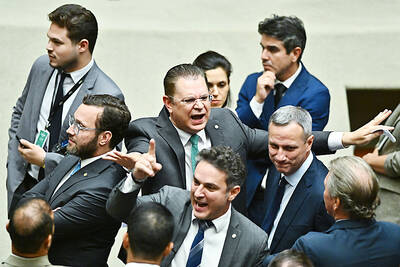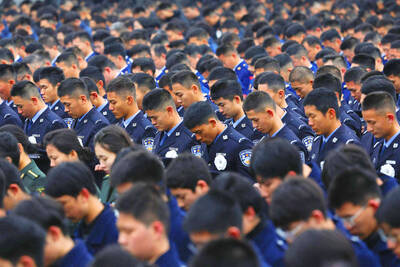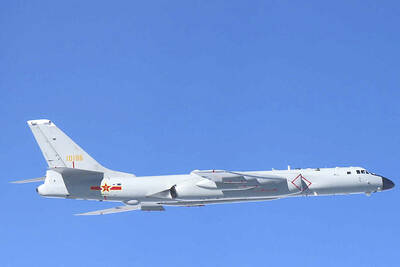“Microbeads. A blue one — and a pink one.”
Armed with a pair of tweezers, Jean-Francois Ghiglione examines the samples fished from London’s River Thames by scientists in search of the source of microplastic pollution.
“We find completely different things to what we see in the oceans, for example very tiny microbeads from cosmetic products,” said Ghiglione, head bent over a magnifying glass on a ship owned by the Tara Foundation, which is conducting the study.
From the Pacific to the Arctic Ocean, the scientific vessel has observed the omnipresence of microplastic particles, often no bigger than rice grains, in the seas of the world, but this time Tara decided to throw its nets across 10 of the 15 biggest European rivers, from the Thames to the Tiber, the Rhine to the Seine.
About 8 million tonnes of plastic end up in the world’s oceans every year.
Scientists long believed that ocean microplastics came from larger fragments that were broken down over time by currents, bacteria and UV light, but a growing body of research shows how the microscopic particles are already in rivers before they reach the high seas.
The Tara mission aims to “understand where it comes from: the gutters, industry, our own everyday life,” Tara director Romain Trouble said. “It’s on our doorstep ... the biggest problem with plastic in the sea is on land.”
Trouble said that he is convinced it is possible to “stop the leakage,” starting with getting rid of “unnecessary packaging,” but to stem the flow more effectively, the exact origin of the pollution must be found.
For this reason, the Tara team is to cast its nets of fine mesh across 10 rivers at sites of varying salinity, upstream and downstream of big cities.
A meticulous process in the ship’s onboard laboratory sees each piece of plastic between 1mm and 5mm picked out with tweezers, cut in two and individually placed in thousands of different tubes.
Half of the tubes stored until November are to be used to identify the types of plastic and trace it back to the original product. The other half would allow the scientists to make a list of all the species inhabiting the “plastisphere,” an artificial habitat used as a “raft” by numerous aquatic microorganisms.
Downstream other researchers are collecting spoons and straws left strewn on the river bank by the high tide, as biologist Leila Meistertsheim searches for crates of mussels she placed in the water a month earlier.
“The mussels are open mouths, they swallow everything, so the idea is to use them as bio-indicators,” Meistertsheim said.
Dissected and frozen in liquid nitrogen, the mussels are then freeze-dried to count the microplastic content in their tissue.
A third of the molluscs collected at one site were dead. Test results are yet to determine the cause, but the sites where they were placed were undoubtedly polluted.
“At low tide, there is a carpet of microplastics: toothbrushes, pens, straws, lollipop sticks and many objects unidentifiable with the naked eye,” Meistertsheim said. “The first time I went there, I was scared.”
There is growing evidence to suggest microplastics can enter the human food chain.
A WWF report has claimed the average person could swallow up to 5g of plastic a week, equivalent to a credit card.
However, the danger of these plastics and their chemical additives for living creatures is still unknown.
So “each piece of plastic will be analyzed by its composition, its pollution, the species living on it and the effect it has on the organisms”, Ghiglione said.
However, the global conclusions of the 40 scientists and 12 associated laboratories would only be known in a few years, he added.
Tara’s ship has since made its way to Hamburg, where on the River Elbe, as on the Thames, it is confronted with giant cargo traffic as it conducts its meticulous work.
“It’s like trying to catch butterflies with a net on Place de la Concorde in Paris during rush hour,” captain Martin Hertau said.

PARLIAMENT CHAOS: Police forcibly removed Brazilian Deputy Glauber Braga after he called the legislation part of a ‘coup offensive’ and occupied the speaker’s chair Brazil’s lower house of Congress early yesterday approved a bill that could slash former Brazilian president Jair Bolsonaro’s prison sentence for plotting a coup, after efforts by a lawmaker to disrupt the proceedings sparked chaos in parliament. Bolsonaro has been serving a 27-year term since last month after his conviction for a scheme to stop Brazilian President Luiz Inacio Lula da Silva from taking office after the 2022 election. Lawmakers had been discussing a bill that would significantly reduce sentences for several crimes, including attempting a coup d’etat — opening up the prospect that Bolsonaro, 70, could have his sentence cut to

China yesterday held a low-key memorial ceremony for the 1937 Nanjing Massacre, with Chinese President Xi Jinping (習近平) not attending, despite a diplomatic crisis between Beijing and Tokyo over Taiwan. Beijing has raged at Tokyo since Japanese Prime Minister Sanae Takaichi last month said that a hypothetical Chinese attack on Taiwan could trigger a military response from Japan. China and Japan have long sparred over their painful history. China consistently reminds its people of the 1937 Nanjing Massacre, in which it says Japanese troops killed 300,000 people in what was then its capital. A post-World War II Allied tribunal put the death toll

A passerby could hear the cacophony from miles away in the Argentine capital, the unmistakable sound of 2,397 dogs barking — and breaking the unofficial world record for the largest-ever gathering of golden retrievers. Excitement pulsed through Bosques de Palermo, a sprawling park in Buenos Aires, as golden retriever-owners from all over Argentina transformed the park’s grassy expanse into a sea of bright yellow fur. Dog owners of all ages, their clothes covered in dog hair and stained with slobber, plopped down on picnic blankets with their beloved goldens to take in the surreal sight of so many other, exceptionally similar-looking ones.

‘UNWAVERING ALLIANCE’: The US Department of State said that China’s actions during military drills with Russia were not conducive to regional peace and stability The US on Tuesday criticized China over alleged radar deployments against Japanese military aircraft during a training exercise last week, while Tokyo and Seoul yesterday scrambled jets after Chinese and Russian military aircraft conducted joint patrols near the two countries. The incidents came after Japanese Prime Minister Sanae Takaichi triggered a dispute with Beijing last month with her remarks on how Tokyo might react to a hypothetical Chinese attack on Taiwan. “China’s actions are not conducive to regional peace and stability,” a US Department of State spokesperson said late on Tuesday, referring to the radar incident. “The US-Japan alliance is stronger and more